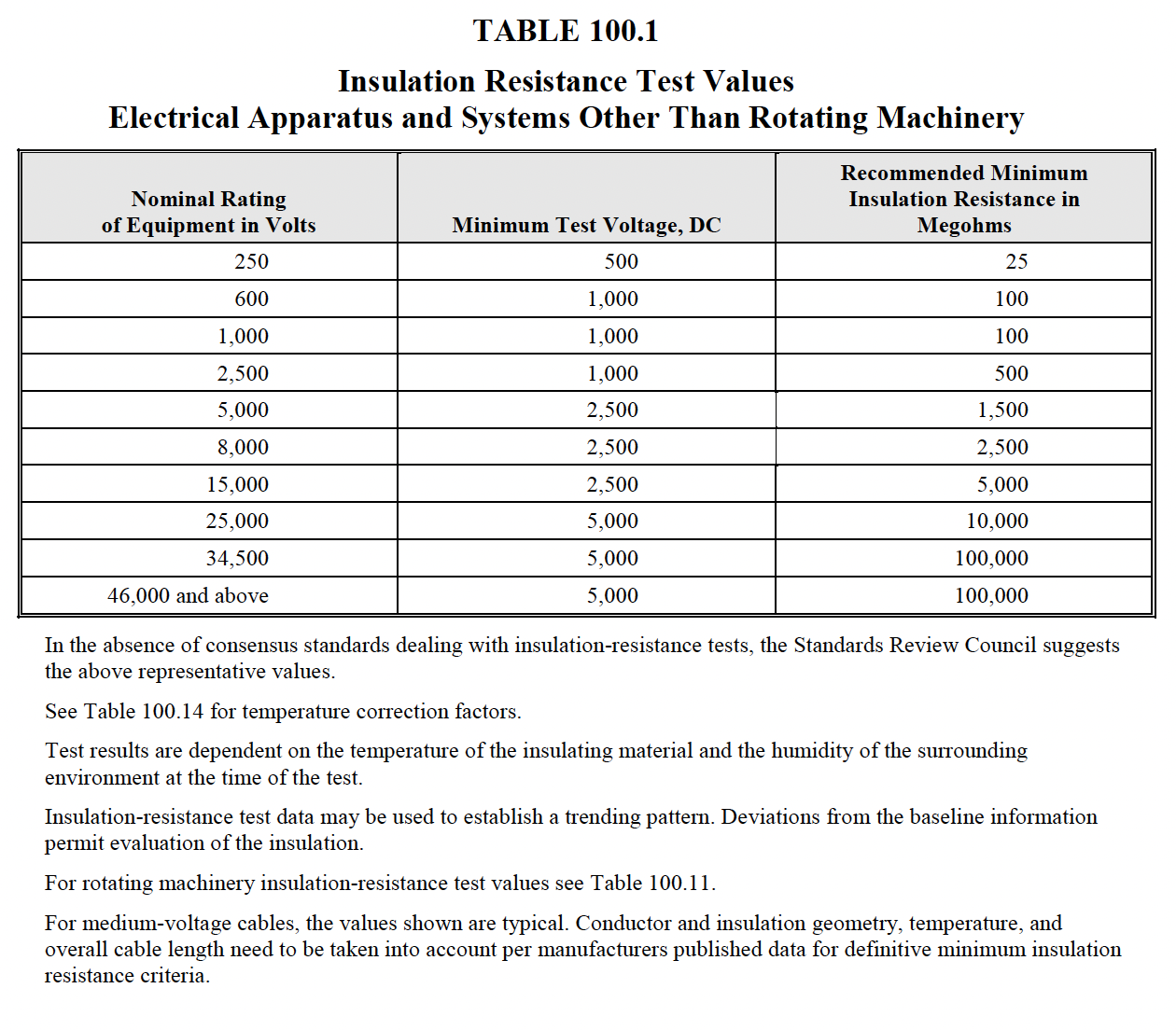NETA ATS
7.4 Metal-Enclosed Busways
A.
Visual and Mechanical Inspection:
- Compare equipment nameplate data with drawings and specifications.
- Inspect physical and mechanical condition.
- Inspect anchorage, alignment, and grounding.
- Verify correct connection in accordance with single-line diagram.
- Inspect bolted electrical connections for high resistance using one or more of the following
methods:
- Use of a low-resistance ohmmeter in accordance with Section 7.1.B.1.
- Verify tightness of accessible bolted electrical connections by calibrated torquewrench
method in accordance with manufacturer’s published data or Table 100.12.
- Perform thermographic survey in accordance with Section 9.
- Confirm physical orientation in accordance with manufacturer’s labels to insure adequate
cooling.
- Examine outdoor busway for removal of “weep-hole” plugs, if applicable, and the correct
installation of joint shield.
B.
Electrical Tests:
- Perform resistance measurements through bolted connections and bus joints with a lowresistance
ohmmeter, if applicable, in accordance with Section 7.4.A.
- Measure insulation resistance of each busway, phase-to-phase and phase-to-ground for one
minute, in accordance with Table 100.1.
- Perform a dielectric withstand voltage test on each busway, phase-to-ground with phases not
under test grounded, in accordance with manufacturer’s published data. In the absence of
manufacturer’s published data, use Table 100.17. Where no dc test value is shown in Table
100.17, an ac value shall be used. The test voltage shall be applied for one minute.
- Measure resistance of assembled busway sections on insulated busway and compare values
with adjacent phases.
- Perform phasing test on each busway tie section energized by separate sources. Tests must
be performed from their permanent sources.
- Verify operation of busway space heaters.
C.
Test Values – Visual and Mechanical
- Compare bolted connection resistance values to values of similar connections. Investigate
values which deviate from those of similar bolted connections by more than 50 percent of the
lowest value. (7.4.A.5.1)
- Bolt-torque levels should be in accordance with manufacturer’s published data. In the
absence of manufacturer’s published data, use Table 100.12. (7.4.A.5.2)
- Results of the thermographic survey shall be in accordance with Section 9. (7.4.A.5.3)
D.
Test Values – Electrical
- Compare bolted connection resistance values to values of similar connections. Investigate
values which deviate from those of similar bolted connections by more than 50 percent of the
lowest value.
- Insulation-resistance test voltages and resistance values shall be in accordance with
manufacturer’s published data or Table 100.1. In the absence of manufacturer’s published
data, minimum resistance values are for a nominal 1000-foot busway run. Use the following
formula to convert the measured resistance value to the 1000-foot nominal value:
Converted values of insulation resistance less than those in Table 100.1 or manufacturer’s
minimum should be investigated. Dielectric withstand voltage tests shall not proceed until
insulation-resistance levels are raised above minimum values.
- If no evidence of distress or insulation failure is observed by the end of the total time of
voltage application during the dielectric withstand test, the test specimen is considered to
have passed the test.
- Microhm or dc millivolt drop values shall not exceed the high levels of the normal range as
indicated in the manufacturer’s published data. If manufacturer’s published data is not
available, investigate values which deviate from those of similar bus connections and
sections by more than 50 percent of the lowest value.
- Phasing test results shall indicate the phase relationships are in accordance with system
design.
- Heaters shall be operational.
NETA MTS
7.4 Metal-Enclosed Busways
A.
Visual and Mechanical Inspection:
- Inspect physical and mechanical condition.
- Inspect anchorage, alignment, and grounding.
- Inspect bolted electrical connections for high resistance using one or more of the following
methods:
- Use of a low-resistance ohmmeter in accordance with Section 7.1.B.1.
- Verify tightness of accessible bolted electrical connections by calibrated torquewrench
method in accordance with manufacturer’s published data or Table 100.12.
- Perform thermographic survey in accordance with Section 9.
- Confirm physical orientation in accordance with manufacturer’s labels to ensure adequate
cooling.
- Examine outdoor busway for removal of “weep-hole” plugs and for the correct installation
of joint shield.
- Inspect and clean ventilating openings.
B.
Electrical Tests:
- Perform resistance measurements through bolted connections and bus joints with a lowresistance
ohmmeter in accordance with Section 7.4.A.3.1.
- Perform insulation resistance tests on each busway for one minute, phase-to-phase and
phase-to-ground. Apply voltage in accordance with manufacturer’s published data. In the
absence of manufacturer’s published data, use Table 100.1.
- Perform a dielectric withstand voltage test on each busway, phase-to-ground with phases
not under test grounded, in accordance with manufacturer’s published data. If manufacturer
has no recommendation for this test, it shall be in accordance with Table 100.17. Where no
dc test value is shown in Table 100.17, ac value shall be used. The test voltage shall be
applied for one minute.
- *Perform a dielectric withstand voltage test on each busway, phase-to-ground with phases
not under test grounded, in accordance with manufacturer’s published data. If manufacturer
has no recommendation for this test, it shall be in accordance with Table 100.17. Where no
dc test value is shown in Table 100.17, ac value shall be used. The test voltage shall be
applied for one minute.
- Verify operation of busway space heaters.
- *Perform online partial-discharge survey in accordance with Section 11.
C.
Test Values – Visual and Mechanical
- Compare bolted connection resistance values to values of similar connections. Investigate
values which deviate from those of similar bolted connections by more than 50 percent of
the lowest value. (7.4.A.3.1)
- Bolt-torque levels should be in accordance with manufacturer’s published data. In the
absence of manufacturer’s published data, use Table 100.12. (7.4.A.3.2)
- Results of the thermographic survey shall be in accordance with Section 9. (7.4.A.3.3)
D.
Test Values – Electrical
- Compare bolted connection resistance values to values of similar connections. Investigate
values which deviate from those of similar bolted connections by more than 50 percent of
the lowest value.
- Insulation-resistance test voltages and resistance values shall be in accordance with
manufacturer’s published data or Table 100.1. In the absence of manufacturer’s published
data, minimum resistance values are for a nominal 1000-foot busway run. Use the following
formula to convert the measured resistance value to the 1000-foot nominal value:
Converted values of insulation resistance less than those in Table 100.1 or manufacturer’s
minimum should be investigated. Dielectric withstand voltage tests shall not proceed until
insulation-resistance levels are raised above minimum values.
- If no evidence of distress or insulation failure is observed by the end of the total time of
voltage application during the dielectric withstand voltage test, the test specimen is
considered to have passed the test.
- Microhm or dc millivolt drop values should not exceed the high levels of the normal range
as indicated in the manufacturer’s published data. If manufacturer’s data is not available,
investigate values which deviate from those of similar bus connections and sections by
more than 50 percent of the lowest value.
- Results of online partial-discharge survey should be in accordance with manufacturer’s
published data. In the absence of manufacturer’s published data, refer to Table 100.23.
|










